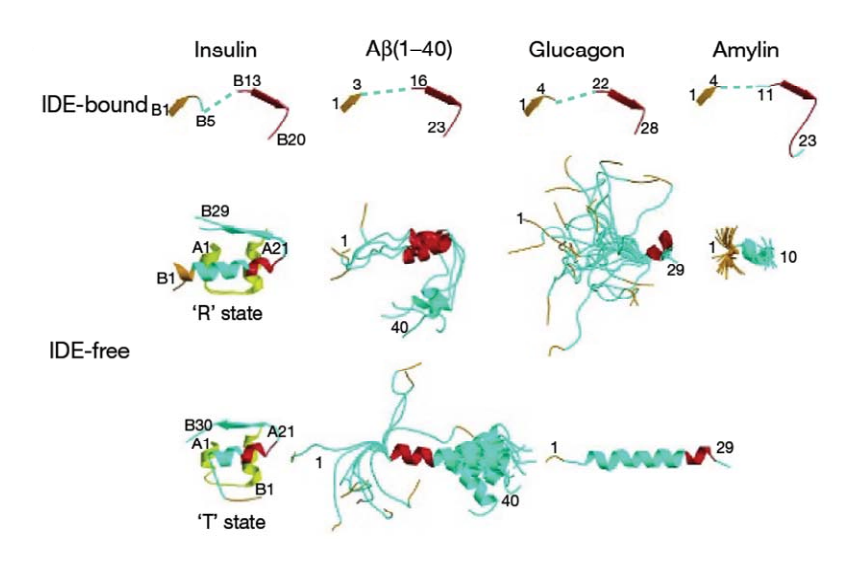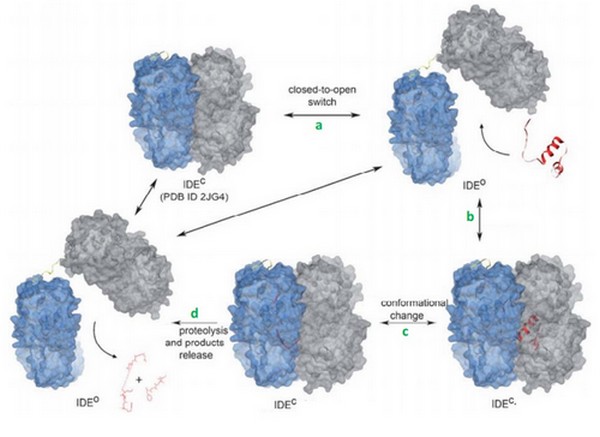Sandbox Reserved 972
From Proteopedia
(Difference between revisions)
| Line 2: | Line 2: | ||
<StructureSection load='3cww' size='340' side='right' caption='Caption for this structure' scene=''> | <StructureSection load='3cww' size='340' side='right' caption='Caption for this structure' scene=''> | ||
| - | Insulin Degrading Enzyme (or IDE [http://www.proteopedia.org/wiki/index.php/Insulin-Degrading_Enzyme]) plays an important role in the cellular degradation of many molecules. Its activity was first related only to insulin, but now, we know that IDE interacts with insulin, glugacon and bradykinin. | + | '''Insulin Degrading Enzyme''' (or IDE [http://www.proteopedia.org/wiki/index.php/Insulin-Degrading_Enzyme]) plays an important role in the cellular degradation of many molecules. Its activity was first related only to insulin, but now, we know that IDE interacts with insulin, glugacon and bradykinin. |
The IDE-bradykinin complex has a complexity in the substrate binding and recognition mechanism of IDE. | The IDE-bradykinin complex has a complexity in the substrate binding and recognition mechanism of IDE. | ||
==Insuline degrading enzyme== | ==Insuline degrading enzyme== | ||
| - | <scene name='60/604491/Ide/1'>IDE</scene> (EC 3.4.24.56) is a human enzyme of the metallopeptidase family. It is composed by more than 1000 residues and has a huge catalytic cavity. It is made of 2 parts linked by a loop, and it switches between an open and a close state. The size of its catalytic chamber allows the binding of peptides (70 amino acids long). IDE hydrolyzes a lot of substrates which have many differents biological activities. Its substrate can be insuline, glucagon, amyline or bradykinin. This enzyme hydrolyses its substrates by cleaving them at different points. | + | <scene name='60/604491/Ide/1'>IDE</scene> (EC 3.4.24.56) is a human enzyme of the '''metallopeptidase''' family. It is composed by more than 1000 residues and has a huge catalytic cavity. It is made of 2 parts linked by a loop, and it switches between '''an open and a close state'''. The size of its catalytic chamber allows the binding of peptides (70 amino acids long). IDE hydrolyzes a lot of substrates which have many differents biological activities. Its substrate can be insuline, glucagon, amyline or bradykinin. This enzyme hydrolyses its substrates by cleaving them at different points. |
===Exosite: an essential element for the catalysis=== | ===Exosite: an essential element for the catalysis=== | ||
| - | Previous studies reveal that IDE uses an exosite to interact with the N-terminal end of its substrate<ref>doi: 10.1074/jbc.M701590200</ref>. This exosite is completely different from the catalytic site, but it is an essential component for the substrate hydrolysis. Actually, it plays a role in the docking of substrates on IDE. Actually, when substrates arrive, they first bind to the exosite and then, they are translocated to the catalytic site. They have to change their conformation<ref> doi: 10.1038/nature05143</ref> in order to access to the catalytic site. It was also observed that the binding of bradykinin occurs at the exosite and not the catalytic site. | + | Previous studies reveal that IDE uses an '''exosite''' to interact with the N-terminal end of its substrate<ref>doi: 10.1074/jbc.M701590200</ref>. This exosite is completely different from the catalytic site, but it is an essential component for the substrate hydrolysis. Actually, it plays a role in the docking of substrates on IDE. Actually, when substrates arrive, they first bind to the exosite and then, they are translocated to the catalytic site. They have to change their conformation<ref> doi: 10.1038/nature05143</ref> in order to access to the catalytic site. It was also observed that the binding of bradykinin occurs at the exosite and not the catalytic site. |
[[Image:proteoproteo.png]] | [[Image:proteoproteo.png]] | ||
| Line 36: | Line 36: | ||
==Hypothetical role of bradykinin on IDE== | ==Hypothetical role of bradykinin on IDE== | ||
| - | Bradykinin is well known as an activator of IDE (34). Consequently, the binding of one bradykinin at the exosite must have an influence on the binding of other substrates. Actually, small peptides like bradykinin can reduce the catalytic chamber by the binding to the exosite. This leads to an increase of the binding of other substrates and the subsequent cleavage by IDE. Alternatively, bradykinin binding could reduce the cleavage by interfering with substrate binding. | + | Bradykinin is well known as an '''activator''' of IDE (34). Consequently, the binding of one bradykinin at the exosite must have an influence on the binding of other substrates. Actually, small peptides like bradykinin can reduce the catalytic chamber by the binding to the exosite. This leads to an increase of the binding of other substrates and the subsequent cleavage by IDE. Alternatively, bradykinin binding could reduce the cleavage by interfering with substrate binding. |
Today, we can supposed that binding of bradykinin at the exosite stimulated the conformationnal change of IDE, from its open to its close state. Binding of bradykinin or other short peptides to the exosite could play a regulatory role in substrate binding and cleavage by IDE<ref>doi: 10.1021/bi801192h</ref>. | Today, we can supposed that binding of bradykinin at the exosite stimulated the conformationnal change of IDE, from its open to its close state. Binding of bradykinin or other short peptides to the exosite could play a regulatory role in substrate binding and cleavage by IDE<ref>doi: 10.1021/bi801192h</ref>. | ||
Current revision
| This Sandbox is Reserved from 15/11/2014, through 15/05/2015 for use in the course "Biomolecule" taught by Bruno Kieffer at the Strasbourg University. This reservation includes Sandbox Reserved 951 through Sandbox Reserved 975. |
To get started:
More help: Help:Editing |
| |||||||||||
References
- ↑ Im H, Manolopoulou M, Malito E, Shen Y, Zhao J, Neant-Fery M, Sun CY, Meredith SC, Sisodia SS, Leissring MA, Tang WJ. Structure of substrate-free human insulin-degrading enzyme (IDE) and biophysical analysis of ATP-induced conformational switch of IDE. J Biol Chem. 2007 Aug 31;282(35):25453-63. Epub 2007 Jul 5. PMID:17613531 doi:10.1074/jbc.M701590200
- ↑ Shen Y, Joachimiak A, Rosner MR, Tang WJ. Structures of human insulin-degrading enzyme reveal a new substrate recognition mechanism. Nature. 2006 Oct 19;443(7113):870-4. Epub 2006 Oct 11. PMID:17051221 doi:10.1038/nature05143
- ↑ Song ES, Juliano MA, Juliano L, Hersh LB. Substrate activation of insulin-degrading enzyme (insulysin). A potential target for drug development. J Biol Chem. 2003 Dec 12;278(50):49789-94. Epub 2003 Oct 2. PMID:14527953 doi:http://dx.doi.org/10.1074/jbc.M308983200
- ↑ Malito E, Ralat LA, Manolopoulou M, Tsay JL, Wadlington NL, Tang WJ. Molecular Bases for the Recognition of Short Peptide Substrates and Cysteine-Directed Modifications of Human Insulin-Degrading Enzyme. Biochemistry. 2008 Nov 6. PMID:18986166 doi:10.1021/bi801192h
- ↑ Im H, Manolopoulou M, Malito E, Shen Y, Zhao J, Neant-Fery M, Sun CY, Meredith SC, Sisodia SS, Leissring MA, Tang WJ. Structure of substrate-free human insulin-degrading enzyme (IDE) and biophysical analysis of ATP-induced conformational switch of IDE. J Biol Chem. 2007 Aug 31;282(35):25453-63. Epub 2007 Jul 5. PMID:17613531 doi:10.1074/jbc.M701590200


